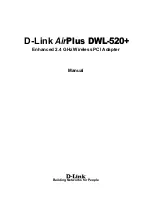
8
Wireless Basics
802.1x provides an extra level of security to your wireless network. Through
its Authentication protocol (when 802.1x is activated), only clients with
802.1x authentication will be permitted to communicate in your network; all
other clients will be denied access. This is a far more secure wireless
network than has previously been available.
All devices on the network must be 802.1x compatible and must share the
same EAP type. For Authentication purposes you will need a radius server
in your network.
Installation Considerations
Designed to go up to 1,312 feet (400 meters) outdoors and up to 328 feet
(100 meters) indoors, the D-Link
Air
Plus DWL-520+ lets you access your
network with your computer from virtually anywhere. Keep in mind, however,
that the number, thickness and location of walls, ceilings or other objects that
the wireless signal must pass thru may limit range. Typical ranges vary
depending on the types of materials and any background RF (radio
frequency) noise in your home or business. The key to maximizing range is
to follow these basic guidelines:
1.
Keep the number of walls and ceilings between the wireless Access
Point and your receiving device (i.e., the DWL-520+) to a minimum -
Each wall or ceiling can reduce your D-Link
Air
Plus Wireless product’s
range from 3-90 feet (1-30 meters.) Position your Access Points,
Residential Gateways, and computers so that the number of walls or
ceilings is minimized.
2. Be aware of the direct line between Access Points, Residential
Gateways (routers), and computers. A wall that is 1.5 feet thick (.5
meters), at a 45-degree angle appears to be almost 3 feet (1 meter) thick.
At a 2-degree angle it looks over 42 feet (14 meters) thick! Try to make
sure that the Access Points and Adapters are positioned so that the
signal will travel straight through a wall or ceiling for better reception.
3. Building Materials make a difference - A solid metal door or aluminum
studs may have a negative effect on range. Try to position Access Points,
and computers with wireless adapters so that the signal passes through
drywall or open doorways and not other materials.
4. Make sure that the device’s antenna is positioned for best reception by
using the software signal strength tools included with your product.
5. Keep your product away (at least 3-6 feet or 1-2 meters) from electrical
devices or appliances that may generate extreme RF noise.









































